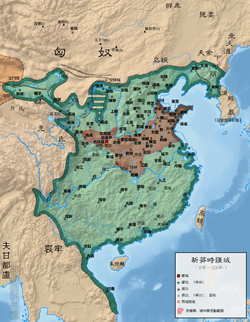Xin dynasty
| Xin dynasty | |||||
| 新朝 | |||||
| |||||
 Xin dynasty (teal) | |||||
| Capital | Chang'an | ||||
| Government | Monarchy | ||||
| Emperor | |||||
| • | 9-23 | Wang Mang | |||
| History | |||||
| • | Wang Mang usurpation | 10 January 9[1] 9 | |||
| • | Chang'an captured by Lülin | 5 October 23[2] 23 | |||
| Currency | Chinese coin, gold, silver, tortoise shell, seashell | ||||
| Today part of | |||||
 | |||||||
|---|---|---|---|---|---|---|---|
| ANCIENT | |||||||
| Neolithic c. 8500 – c. 2070 BC | |||||||
| Xia dynasty c. 2070 – c. 1600 BC | |||||||
| Shang dynasty c. 1600 – c. 1046 BC | |||||||
| Zhou dynasty c. 1046 – 256 BC | |||||||
| Western Zhou | |||||||
| Eastern Zhou | |||||||
| Spring and Autumn | |||||||
| Warring States | |||||||
| IMPERIAL | |||||||
| Qin dynasty 221–206 BC | |||||||
| Han dynasty 206 BC – 220 AD | |||||||
| Western Han | |||||||
| Xin dynasty | |||||||
| Eastern Han | |||||||
| Three Kingdoms 220–280 | |||||||
| Wei, Shu and Wu | |||||||
| Jin dynasty 265–420 | |||||||
| Western Jin | |||||||
| Eastern Jin | Sixteen Kingdoms | ||||||
| Northern and Southern dynasties 420–589 | |||||||
| Sui dynasty 581–618 | |||||||
| Tang dynasty 618–907 | |||||||
| (Wu Zhou interregnum 690–705) | |||||||
| Five Dynasties and Ten Kingdoms 907–960 |
Liao dynasty 907–1125 | ||||||
| Song dynasty 960–1279 |
|||||||
| Northern Song | W. Xia | ||||||
| Southern Song | Jin | ||||||
| Yuan dynasty 1271–1368 | |||||||
| Ming dynasty 1368–1644 | |||||||
| Qing dynasty 1644–1911 | |||||||
| MODERN | |||||||
| Republic of China 1912–1949 | |||||||
| People's Republic of China 1949–present |
Republic of China on Taiwan 1949–present | ||||||
The Xin dynasty (Chinese: 新朝; pinyin: Xīn Cháo; Wade–Giles: Hsin Ch'ao) was a Chinese dynasty (termed so despite having only one emperor) which lasted from 9 to 23 AD. It interrupted the Han dynasty, dividing it into the periods of the Western Han and the Eastern Han.
The sole emperor of the Xin dynasty, Wang Mang, was the nephew of Grand Empress Dowager Wang Zhengjun. After the death of her step-grandson Emperor Ai in 1 BC, Wang Mang rose to power. After several years of cultivating a personality cult, he finally proclaimed himself emperor in 9 AD. However, while a creative scholar and politician, he was an incompetent ruler, and his capital Chang'an was besieged by peasant rebels in 23 AD. He died in the siege, and the Han dynasty was restored by descendants of the former imperial clan.
| Personal name | Portrait | Period of reign | Era names and dates |
|---|---|---|---|
| Wang Mang | 9–23 AD |
Shijianguo (始建國 Shǐ Jìan Guǒ, "Start to establish a nation") 9–13 AD |
Notes
- ↑ Zizhi Tongjian, vol. 36.
- ↑ Zizhi Tongjian, vol. 39.
References
- Book of Han, vol. 99, parts 1, 2, 3.
- Zizhi Tongjian, vols. 36, 37, 38, 39.
- Yap, Joseph P. Wars With the Xiongnu - A translation from Zizhi tongjian Chapter 13–17 - pp 404–601 ISBN 978-1-4490-0605-1 (sc)
| |||||||||||||||||||||||||||||
